I'm not sure how many times I told customers that I would never make a large version of our rat proof chicken feeder, that it wasn't feasible for several reasons but it turns out there was a way to get it done and escape some of the hold backs.
One of the issues was making a longer door meant the door was heavier, too heavy for a normal sized bird to operate. On my last trip to the Philippines to visit my shop I found myself with a few extra days so I set about tinkering to solve the problems. Adding 4" to the door opening allowed the feed capacity to go from around 24-25 pounds (stuffed to the gills!) to 37 pounds of feed and the door spaced will allow three to four birds to eat at a time. The number of birds that can eat at once has always been an initial customer concern but not really a practical concern.
What we found was that doubling the counterweight handled the added weight of the door but that the treadle lost stiffness, a bird stepping on the far left side flexed the treadle quite a bit before the slack was taken up and the door moved. Adding a full width wood treadle step rather than the usual shortened wood treadle step fixed that issue, a bit more time consuming to fit, but the weight of the door and treadle assembly was pushing the limit for a medium sized chicken to move.
What was needed was a heavier counterweight or better, a counterweight on both sides and a wire link connecting the door axle to the treadle on both sides. The existing welded door crank has worked well and statistically it has been trouble free and dependable but one side had to be left small enough to thread the axle in place; it would be impossible to bend both ends into a door crank and assemble the feeder and allow customer repair of the feeder on down the road.
What I came up with was a completely new door axle design, both ends can be open, the bent door crank on one end replaced by two blocks of steel that were time consuming and expensive to make but it allowed a double wire link and was easy to assemble and repair. A flat spot was ground on the round steel bar axle so that the new door crank blocks wouldn't slip. It had the added benefit of trapping the axle in place, preventing the door axle and the attached door from moving back and forth due to the angle and pressure of the wire link, keeping the door centered.
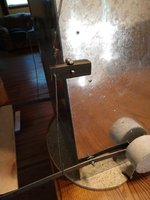
An added feature was the new design will allow a soft close cylinder to mount under the door crank block on the back side, preventing the clashing of the soft close cylinder and the door pre load spring. I have yet to have the time to play with adding the soft close but it looks like instead of the large wooden bar with the soft close cylinder perched on the end I can just add a different type soft close cylinder directly to the side of the feeder and pre install the soft close without risking shipping damage to a protruding part.
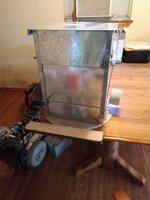
With the major issues out of the way there remained several issues that aren't possible to address; the added cost due to the complexity of manufacturing and the added bulk adding to the already crazy shipping costs due to feeders being oversized packages. While the feed capacity went up 40%, so did the cost, from $65.00 to $99.70, but I had always held that it would be cheaper to make and purchase two feeders rather than produce a large version. Then again some coops simply don't have the room for two feeders so the new 14.5" width will feed more birds than the original 10.5" width. The estimated shipping did go up as expected, the large version would cost $37.00 to ship to Modesto CA versus around $32.00 for the medium feeder. Yet that was cheaper than sending two feeders.
The remaining issue was the sheer weight of 37 pounds of feed. I always assumed that adding 40% weight meant increasing the sheet metal gauge to carry the load and we were already at the limit that the workers, some of which are girls, could hand punch during assembly. To get around that I added an adjustable throat down inside the bottom of the angled feed hopper and added folds to the end of the feed tray to stiffen it as well as adding a 1/2" wide flange on the top of the adjustable throat plate. That does impede the flow of feed but that is why the throat needed to be adjustable so it balances out nicely. A single bolt was used to make the new part easy to produce and ensure that every one would fit when massed produced so it is possible to get the thing "cocked" or at an angle but it is a small matter to tighten the bolt to fix that. A bit of feed will pile up on the top of that stiffening flange so the last cup or so of feed in the feeder won't be accessible to the birds. The view below is before that feed tray is assembled to the sides of the feeder.
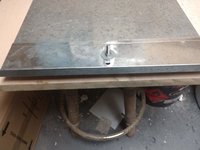
A view down from the top of the feeder, the lid is at the top of the picture, the front of the feeder is at the bottom of the picture, showing the stiffening flange on the new adjustable throat plate.
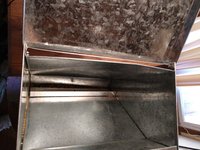
With the major issues dealt with I wondered if it was possible to build the Holy Grail of chicken feeders; one that would accept a full fifty pound sack of feed. I added 10" of height, initially made the part that forms the back/bottom/front tray/anti feed raking lip too long to fold on our sheet metal brake but that was solved by retaining the original part and adding a 10" tall back panel on the back and a 10" tall extra front cover. Adding a 2" wide flange at the base of the front panel stiffened it up to the point that the increased weight is handled well enough and the plan is to require the customer to use the back spacer block that is included with the feeder for mounting right in the center of the back panel seam to stiffen that side. Basically we are using the coop wall or post to help stiffen the back of the feeder.
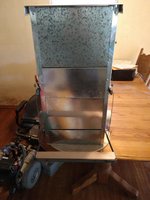
Now the spring was too far from the top of the feeder where we have been inserting the top end so the solution was to drill a series of four holes in the side of both sides of the feeder, allowing two door pre load springs to be used and adding some much needed spring adjust-ability rather than having to stretch the spring with two pairs of pliers to lessen the amount of force.
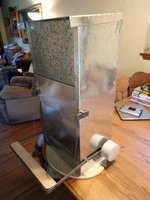
A price was paid for the two and a half times feed capacity, from 25 pounds stuff to the gills to around 67 pounds stuffed to the gills, time and materials to manufacture also went up to where the new extra large feeder will cost $181.35. Shipping went up from around $32.00 for a medium feeder to Modesto CA to $52.00, less than the cost of three feeders shipped to the same zip code.
The down side, despite having over a 50 pound sack of feed available, the space available for chickens to eat has increased a bit less than 60%. The cost is less than three feeders and the shipping is less than three feeders but the space taken up in the coop is also just 4" wider than a medium feeder.
The only real competition is the wonderful fit and finish Grandpa feeder that holds 40 pounds and costs a bit more than this new extra large feeder that holds 67% more feed. However it has 26% bad reviews on Amazon with around thirty customers stating that it isn't mouse proof, leaks, and I don't think the average customer is going to go with pretty over effective.
These won't be available for about three months, enough time to build around 400 feeders to complete a container load before I can ship and maybe six weeks to get that container to the U.S.. I believed that the initial design was solid enough to start the first two batches of 100 each of each size but would love to hear any feedback so that changes could be made on the second batches.
As always, it will be an ugly, unpolished feeder, a bit crude even, but the feed always flows, the feed stays dry if you order the exterior version (and usually the interior version stayed dry even if used outside), it will have a soft close version available, and the feeder design is far, far, safer than the guillotine style feeders, especially the ones that have added side guards that provide an excellent pinch point for a chicken's head.
So feedback please. The original rat proof chicken feeder was developed on this very forum and the criticism helped make it a better feeder.
One of the issues was making a longer door meant the door was heavier, too heavy for a normal sized bird to operate. On my last trip to the Philippines to visit my shop I found myself with a few extra days so I set about tinkering to solve the problems. Adding 4" to the door opening allowed the feed capacity to go from around 24-25 pounds (stuffed to the gills!) to 37 pounds of feed and the door spaced will allow three to four birds to eat at a time. The number of birds that can eat at once has always been an initial customer concern but not really a practical concern.
What we found was that doubling the counterweight handled the added weight of the door but that the treadle lost stiffness, a bird stepping on the far left side flexed the treadle quite a bit before the slack was taken up and the door moved. Adding a full width wood treadle step rather than the usual shortened wood treadle step fixed that issue, a bit more time consuming to fit, but the weight of the door and treadle assembly was pushing the limit for a medium sized chicken to move.
What was needed was a heavier counterweight or better, a counterweight on both sides and a wire link connecting the door axle to the treadle on both sides. The existing welded door crank has worked well and statistically it has been trouble free and dependable but one side had to be left small enough to thread the axle in place; it would be impossible to bend both ends into a door crank and assemble the feeder and allow customer repair of the feeder on down the road.
What I came up with was a completely new door axle design, both ends can be open, the bent door crank on one end replaced by two blocks of steel that were time consuming and expensive to make but it allowed a double wire link and was easy to assemble and repair. A flat spot was ground on the round steel bar axle so that the new door crank blocks wouldn't slip. It had the added benefit of trapping the axle in place, preventing the door axle and the attached door from moving back and forth due to the angle and pressure of the wire link, keeping the door centered.

An added feature was the new design will allow a soft close cylinder to mount under the door crank block on the back side, preventing the clashing of the soft close cylinder and the door pre load spring. I have yet to have the time to play with adding the soft close but it looks like instead of the large wooden bar with the soft close cylinder perched on the end I can just add a different type soft close cylinder directly to the side of the feeder and pre install the soft close without risking shipping damage to a protruding part.

With the major issues out of the way there remained several issues that aren't possible to address; the added cost due to the complexity of manufacturing and the added bulk adding to the already crazy shipping costs due to feeders being oversized packages. While the feed capacity went up 40%, so did the cost, from $65.00 to $99.70, but I had always held that it would be cheaper to make and purchase two feeders rather than produce a large version. Then again some coops simply don't have the room for two feeders so the new 14.5" width will feed more birds than the original 10.5" width. The estimated shipping did go up as expected, the large version would cost $37.00 to ship to Modesto CA versus around $32.00 for the medium feeder. Yet that was cheaper than sending two feeders.
The remaining issue was the sheer weight of 37 pounds of feed. I always assumed that adding 40% weight meant increasing the sheet metal gauge to carry the load and we were already at the limit that the workers, some of which are girls, could hand punch during assembly. To get around that I added an adjustable throat down inside the bottom of the angled feed hopper and added folds to the end of the feed tray to stiffen it as well as adding a 1/2" wide flange on the top of the adjustable throat plate. That does impede the flow of feed but that is why the throat needed to be adjustable so it balances out nicely. A single bolt was used to make the new part easy to produce and ensure that every one would fit when massed produced so it is possible to get the thing "cocked" or at an angle but it is a small matter to tighten the bolt to fix that. A bit of feed will pile up on the top of that stiffening flange so the last cup or so of feed in the feeder won't be accessible to the birds. The view below is before that feed tray is assembled to the sides of the feeder.

A view down from the top of the feeder, the lid is at the top of the picture, the front of the feeder is at the bottom of the picture, showing the stiffening flange on the new adjustable throat plate.

With the major issues dealt with I wondered if it was possible to build the Holy Grail of chicken feeders; one that would accept a full fifty pound sack of feed. I added 10" of height, initially made the part that forms the back/bottom/front tray/anti feed raking lip too long to fold on our sheet metal brake but that was solved by retaining the original part and adding a 10" tall back panel on the back and a 10" tall extra front cover. Adding a 2" wide flange at the base of the front panel stiffened it up to the point that the increased weight is handled well enough and the plan is to require the customer to use the back spacer block that is included with the feeder for mounting right in the center of the back panel seam to stiffen that side. Basically we are using the coop wall or post to help stiffen the back of the feeder.

Now the spring was too far from the top of the feeder where we have been inserting the top end so the solution was to drill a series of four holes in the side of both sides of the feeder, allowing two door pre load springs to be used and adding some much needed spring adjust-ability rather than having to stretch the spring with two pairs of pliers to lessen the amount of force.

A price was paid for the two and a half times feed capacity, from 25 pounds stuff to the gills to around 67 pounds stuffed to the gills, time and materials to manufacture also went up to where the new extra large feeder will cost $181.35. Shipping went up from around $32.00 for a medium feeder to Modesto CA to $52.00, less than the cost of three feeders shipped to the same zip code.
The down side, despite having over a 50 pound sack of feed available, the space available for chickens to eat has increased a bit less than 60%. The cost is less than three feeders and the shipping is less than three feeders but the space taken up in the coop is also just 4" wider than a medium feeder.
The only real competition is the wonderful fit and finish Grandpa feeder that holds 40 pounds and costs a bit more than this new extra large feeder that holds 67% more feed. However it has 26% bad reviews on Amazon with around thirty customers stating that it isn't mouse proof, leaks, and I don't think the average customer is going to go with pretty over effective.
These won't be available for about three months, enough time to build around 400 feeders to complete a container load before I can ship and maybe six weeks to get that container to the U.S.. I believed that the initial design was solid enough to start the first two batches of 100 each of each size but would love to hear any feedback so that changes could be made on the second batches.
As always, it will be an ugly, unpolished feeder, a bit crude even, but the feed always flows, the feed stays dry if you order the exterior version (and usually the interior version stayed dry even if used outside), it will have a soft close version available, and the feeder design is far, far, safer than the guillotine style feeders, especially the ones that have added side guards that provide an excellent pinch point for a chicken's head.
So feedback please. The original rat proof chicken feeder was developed on this very forum and the criticism helped make it a better feeder.
